| Uncle Al's 2017-2020
Racing Rules in Pics Rules are quoted, then illustrated and explained as seems necessary. Part 2D + Penalty Turns for instant access without scrolling, click on the Rules listed below 21 Exoneration 22 Starting Errors; Taking Penalties; Moving Astern 23 Capsized, Anchored or Aground; Rescuing 24 Interfering with Another Boat 31 Touching a Mark 44 Penalties for Breaking Rules of Part 2 44.1 taking a penalty 44.2 720° turns penalty 44.4 limits on penalties |
|
When rule 21 or 22 applies between two boats, Section A rules do not. |
|
Section A rules are
port/starboard (10),
windward/leeward
(11), clear
astern/clear ahead (12)
and tacking (13).
... |
| 21
Exoneration When a boat is sailing within the room or mark-room to which she is entitled, she shall be exonerated if, in an incident with a boat required to give her that room or mark-room, (a) she breaks a rule of Section A, rule 15 or rule 16, or (b) she is compelled to break rule 31. |
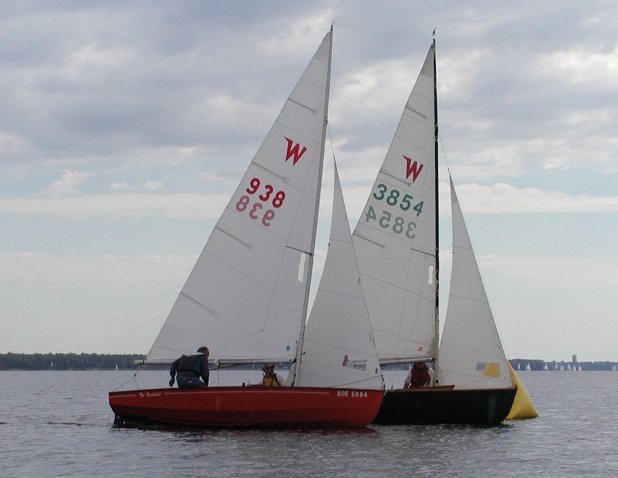 |
| The photo above
illustrates a situation where rule 21 might come
into play. In normal circumstances, rule 16.1 might well
prevent Uncle Al (leeward boat in W3854) from
changing course towards Hans Gottschling (windward
in W938) because the two boats are so close
together that a course change by Al may not leave Hans
enough room to keep clear. But here rule 18 is in effect
so that, as per rule 21, rule 16 does
not apply to Al who is free to alter course as he feels
is necessary to round the mark. Hans must be prepared
for this and make sure he is able to keep clear despite
any (reasonable!) course change (such as luffing above
close-hauled to "shoot the mark") that Al may feel is
required. As I understand it, a protest committee could
find that the inside boat broke rule 15 or 16, thus letting
the outside boat off the hook, and then exonerate the
inside boat if Inside made a proper course rounding. |
| 22
Starting
Errors; Taking Penalties; Moving Astern 22.1 A boat sailing towards the pre-start side of the starting line or one of its extensions after her starting signal to start or to comply with rule 30.1 shall keep clear of a boat not doing so until she is completely on the pre-start side. 22.2 A boat taking a penalty shall keep clear of one that is not. 22.3 A boat moving astern, or sideways to windward, by backing a sail shall keep clear of one that is not. |
In so many words, if you are
... |
| 23
Capsized,
Anchored or Aground; Rescuing If possible, a boat shall avoid a boat that is capsized or has not regained control after capsizing, is anchored or aground, or is trying to help a person or vessel in danger. A boat is capsized when her masthead is in the water. |
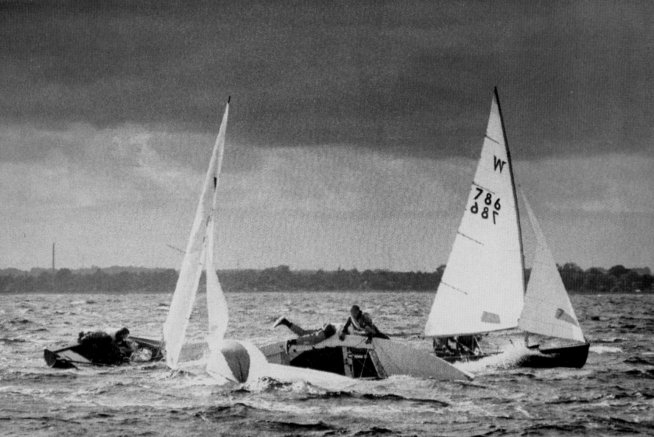 |
|
I believe this photo was
taken during the eventually abandoned first race of the
1989 Wayfarer Worlds in Vallensbæk near Copenhagen. In
these Force 9 (44-knot or 22 m/sec) winds, there was no
lack of capsizes including this beauty by Henrik Koch,
who either had the first-ever Wayfarer with airbags
installed or was trying to fly the spinnaker?? Surely not!!??
...Rule 23 is very much a common sense rule and is one I have never seen broken or invoked. People just naturally do the right thing. A boat that is capsized and/or full of water, anchored or aground (not a Wayfarer of course) is obviously in no position to keep clear. And of course, no one in their right mind would call "starboard" on a boat that is busy rescuing someone. |
| 24
Interfering with Another Boat 24.1 If reasonably possible, a boat not racing shall not interfere with a boat that is racing. 24.2 If reasonably possible, a boat shall not interfere with a boat that is taking a penalty, sailing on another leg or subject to rule 22.1. However, after the starting signal this rule does not apply when the boat is sailing her proper course. |
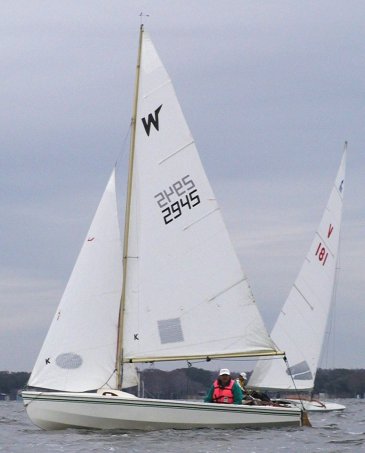 |
| Rule 23 again is a matter of common sense:
23.1: Obviously those
still/already racing should be entitled to do so without
interference from boats not yet/no longer racing. In the
photo above, Mike Murto (W2945) is taking a well-earned
rest by heaving to after single-handing one of the 2003
Midwinters races. In doing so, he must be careful not to
interfere with any of the C Scows still completing their
final beat.
You are "interfering" with another boat if you hit that boat or force it to change course. Taking another boat's wind is not considered by the Rules to be "interfering" (in the expert opinion of Speed'n'Smarts author, Dave Dellenbaugh), but we will all do well to remember - starting with Uncle Al himself!! - how annoyed we get when a bunch of guys who have finished, sometimes sit there blocking all our wind while having lunch right near the finish area. Even to take pictures, I now try to get well clear of boats still fighting it out for finish positions! Note that 23.1
is a unique rule insofar as there will be no penalty
turns remedy available to you if you break it - because
rule 44.1 limits this remedy to
rules of Part 2 broken "while racing"!!
23.2: Again, the poor
guy doing a penalty already has enough troubles without
anyone going out of their way to interfere with the
turn(s)!!
.. |
| Part 3 31 Touching a Mark While racing, a boat shall not touch a starting mark before starting, a mark that begins, bounds or ends the leg of the course on which she is sailing, or a finishing mark after finishing. |
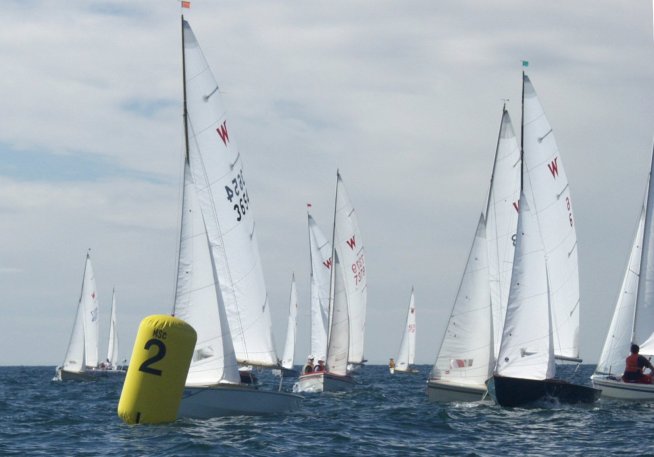 |
|
About 5 seconds
before the start. John Cawthorne (W3654) ends up
"sitting" too close to the favoured "pin" end, and is
unable to get up enough speed to be able to "shoot" the
mark without hitting it. Uncle Al (W6) oddly enough,
starts off slightly to leeward of John but is already up
to speed and will clear the mark (and John) with
relative ease.
...After his brush with the mark, John can keep sailing on starboard (tacking would be risky here!!) and gybe to initiate his penalty turn (see 44.2) as soon as there's no boats he'll interfere with to leeward. Often, it will be possible (but not required!!) to just do the penalty turn right around the mark (as John did!). But he must then remember to end up going in the same direction as he is in the photo, i.e. he can't just gybe to port, harden up and sail away on port. That would not satisfy rule 44.2 (below) which requires a "complete turn including one tack and one gybe"! |
| 44 Penalties
at the Time of an
Incident 44.1 Taking a Penalty A boat may take a Two-Turns Penalty when she may have broken a rule of Part 2 while racing or a One-Turn Penalty when she may have broken rule 31. Sailing instructions may specify the use of the Scoring Penalty or some other penalty. However, (a) when a boat may have broken a rule of Part 2 and rule 31 in the same incident she need not take the penalty for breaking rule 31; (b) if the boat caused injury or serious damage or gained a significant advantage in the race or series by her breach her penalty shall be to retire. 44.2 One-Turn and Two-Turns Penalties After getting well clear of other boats as soon after the incident as possible, a boat takes a One-Turn or Two-Turns Penalty by promptly making the required number of turns in the same direction, each turn including one tack and one gybe. When a boat takes the penalty at or near the finishing line, she shall return completely to the course side of the line before finishing. |
|
Former rule 31.2 is now
part of rule 44 (above).
Pretty straightforward, this! You can (under most
circumstances!) exonerate yourself for hitting a mark by
doing a prompt penalty turn - always remembering that
rule 21 requires you to keep clear
of any boats not doing turns. You can do the penalty
turn by sailing a circle around the mark or not - as you
see fit - so long as the turn is done “as soon as possible”.
...If you hit a finish mark, you can also just gybe around it, tack back onto your original tack on which you hit the mark, and finish. This takes care of the part which says "she shall sail completely to the course side of the line before finishing". Note that rule 44.1(a) points out that if a boat breaks "a rule of Part 2 and rule 31 in the same incident she need not take the penalty for breaking rule 31". In so many words, one penalty per incident is all you need to do. Instead of a picture (which I don't have and which wouldn't help very much!) may I suggest you do as I say not as I do: Don't get so upset - especially in a blow - at having to do a turn or two, that you rip the boat around so fast and in such a rage that you capsize or swamp the boat (as I have done). Tip: Most people find it faster to gybe first (rather than tacking) when initiating a penalty turn. |
|
In my experience, we
Wayfarers always seem to have the Two-Turns Penalty
available to us - except of course if a foul causes
injury or serious damage. I have yet to see a situation
where the "significant advantage" has applied. I suppose
it would apply if a boat came in to the windward mark on
port, faced an endless parade of starboard tackers and
decided to butt in and take a penalty that might cost
her a lot less than waiting for 20 boats to go by?
... |
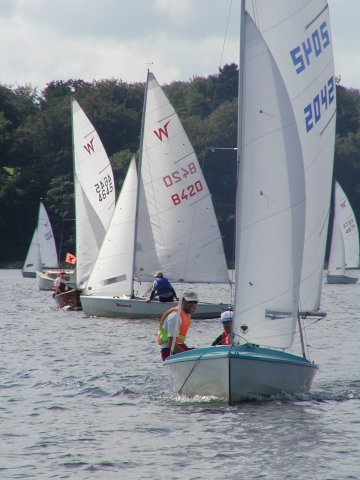 |
|
Three minutes
before the start. If Leif Trier Jensen (W8420,
port tack) fouls Mogens Just (W4645) here, Leif can do a
Two-Turns Penalty to exonerate himself (unless he caused
injury or serious damage). He can - must in
fact - immediately sail well clear of all other boats
and do his turns. With luck, he'll have the turns
completed in time to still have a go at a good start.
... |
|
Rules
in
Pictures index
DefinitionsPart 2A Part 2B Part 2C Part 2D + penalty turns Photo-based Rules Quiz - 1 Photo-based Rules Quiz - 2 |